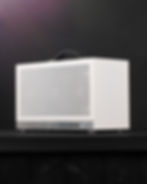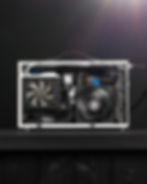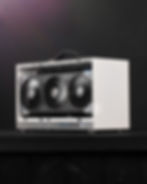S400 - Small, Beautiful, Problematic......
- Sam Thwaytes
- Mar 31
- 8 min read

We build all sorts of systems here at Mr Matt Lee, from the gargantuan HAVN HS420 and the ProArt PA602 right down to the diminutive Jonsbo TK-0. There really a size and spec for all. Each size category has its pros and cons. Full and mid-tower systems have all the hardware support a user is likely to need, but moving the build is no easy feat. Typically a larger build belongs solely on a desk, where it remain for its lifespan. Small form factor PC’s are an exact reverse, hardware support is limited, with a lot of build planning required, but they’re super portable. Many use SFF PCs as part of their home entertainment system in the living room and their size and styling can be in keeping with the rest of the surrounding tech. I guess what is right is a question of intention, where will the build live, what will it be used for, and crucially, how much power do you really need?
Well, the question for us this week is how much power can we get out of something small? Will it be enough to compete with a bigger system? The typical drawbacks are both having to compromise on performance, but also higher operating temps due to limited cooling options. So let’s have a look at something capable, but manageable given the confines of small form factor.

The plan, squeezing a TUF Gaming RTX 5070 and an Intel i5 14600k into The MiniNeo S400, a tiny ITX chassis with limited cooling options and seeing how it performs. We’ve had to choose a low profile air cooler with a slim fan as not much else would fit and we only have space for 2 case fans, both set to exhaust. Is this really a good idea? Well we have done a similar smaller build with this chassis’s little brother with lesser specs, it worked fine, so this should work, right?
Case Overview
Having built with the S300, we knew exactly what to expect - after all the S400 is the same in almost every way, just slightly larger! The case stands at a compact 340 x 155 x 205mm. It will take a mini-ITX motherboard and the manufacturer states it can fit graphics cards up to 335mm if not installing additional storage in this area (there are issues with the claimed sizing, more on that later!). Up top we have space for 2 x 120mm fans, and technically there is space for a further 120mm fan on the bottom, though it’s pretty close to the power supply so we won’t be using that. Talking of power supplies, we have support for SFX or SFX-L. There is no radiator support as there isn’t the space to spare, and air coolers are limited to a height of 67mm (though we’d suggest not going bigger than 65mm to ensure clearance).
The case itself feels as if it's well built, the front and top of the case are made from a single sheet of metal adding to its rigidity. To remove the 2 mesh side panels there are 2 screws and they slide off revealing the internals. Inside the motherboard tray sits about the centre of the case, with space behind to vertically mount the graphics card. The graphics card will need a riser cable to connect to the motherboard. We ordered the version of the case with the PCIe gen 4 riser. We know the RTX 5070 uses PCIe gen 5, but it seems that it currently makes little difference to performance, though that could change in future. We didn’t fancy buying in a gen 5 riser, as that would probably cost more than the case! At the price of the case, it remains to be seen how well the riser cable will perform though!

Parts List

How Was The Build?

Going into the build we’d done a quick mock-up to make sure the motherboard would fit with the cooler attached. We had also mapped out approximate cable management as there is nowhere designed for housing excess cables. The graphics card measurements fell under the case tolerance, so should fit without issue. We’d bought the version of the case with the gen 4 riser which should work fine, perhaps gen 4 is not ideal, but it should work. Really we’d gone to a lot of effort in the planning department, which is something we strongly advise before commencing all small form factor builds. So, surely everything was going to be fine? Nope, that would be too simple!
Getting the motherboard assembled was all very run of the mill, all components fit as they should. Once the motherboard was in, the side of the case went on fine so the choice of cooler had worked. We hadn’t accounted for plugging in the CPU power cable or fan splitters at this point, and as this case demands the motherboard to be orientated upside down so they are inaccessible once the motherboard is screwed in. Out came the motherboard so we could amend.
The power supply mounting was pretty simple, a few screws allowed the bracket to release. Once the PSU was attached, getting in place again was simple enough. I do feel as if we should give a quick, not-sponsored, shout out to the Corsair SF850. We bought this power supply ourselves because it’s small and has short, individually braided cables. It made the build much easier. The cables are the sort that look tidy and bend well but yet want to spring back allowing them to be easily run down a case edge for example. It is an expensive option as it’s an 80 Plus Platinum rated unit, but worth it in my opinion.
Once we got to the graphics card, headaches intensified. The TUF Gaming RTX 5070 is listed as being 329mm long, giving us 6mm of clearance. The claim of having space for graphics cards up to 335mm made by the case manufacturers is technically true, except there is a lip on the front and rear edge of the case reducing the clearance. So, to get a TUF Gaming RTX 5070 would take bending the case, while squeezing the card in. This was not for the faint of heart! We did make it fit after removing a lot of case screws and a fair bit of force - do not try this at home!

Lastly (or at least we thought this was the end), the fans needed to be mounted at the top of the case. A bracket unscrews from the top, attach the fans and replace it, it's that simple…… It should have been if not for the rise cable and graphics card power cables sticking up into the fans. After a bit of messing around with the cables we found a few mm of space to allow free movement, but we’re not confident that in the long term this will remain, we have visions of the top fans chewing up the 12v power cable for the graphics card!

Upon booting the system and telling the bios to use PCIe gen 4 the system exhibited some fairly extreme screen tearing, stuttering and black screen. It seems the riser cable included is of very poor quality. We had to replace it, just as we did in the S300. Though the issue is that this time it wasn't an easy swap. We had to bend the case again to get the graphics card out, swap the riser and bend the case once more to put it back! As the replacement riser was not made for the case it was a little too long and gave us more issues with fan clearance.
Now the build works, technically…….. So lets do some airflow testing.
Airflow
This is going to be an interesting experience. Small for factor builds often deviate from the typical airflow patterns due to limited space for a standard airflow path. For this build the CPU cooler and the graphics card are relying only on their own fans for intake, with the two fans at the top aiding with exhaust. When we add in that the CPU cooler is using a slim fan, it’s going to make cooling a challenge. As you can see from the airflow visualization, both the cooler and graphics card do a good job of dealing with intake and the exhaust fans aid by making sure the hot air leaves the case. Will that be enough to keep the build cool under load? We’ll have a look in a bit.

Noise Testing
As we're testing the full build the results are indicative of that, changing out components would alter results. We use a decibel meter at a distance of 50cm from the PC - which is approx normal seating position in a set-up where the PC is on the desk. The lowest reading available from the device is 30db.
Ambient noise: <30db
Fans at idle (400rpm): <30db
Fans at 50% (900rpm): 31.3db
Fans at 80% (1500rpm): 42db
Performance
There is no escaping that we’re expecting this build to run a little hotter than usual, with limited cooling on the Intel i5 14600K. Temps in the mid 80’s should be fine for this chipset, Intel rate it up to 100°C without thermal throttling, so we’re not too concerned, but let’s see what it does during testing.
Ambient Temp 20.9°C

Cyberpunk 2077
2560x1440
Location: Ghost Town
Custom Preset
DLSS Super Resolution Preset - Transformer Model
DLSS Super Resolution - Performance
Texture Quality - High.
Ray Tracing - On
Path Tracing - On
DLSS Multi Frame Generation - 4X
230-252 FPS
73-96°C CPU
54°C GPU
2560x1440
Location: Ghost Town
Quick Preset: High
Frame Generation: Off
154-187 FPS
73-94°C CPU
54°C GPU
System Power Draw: ~450w

Marvel Rivals
2560 x 1440
Anti Aliasing and Super Resolution Type: Nvidia DLSS
Super Resolution Mode: Quality
Super Resolution Sharpening: 80
Frame Generation Mode: Nvidia DLSS x 4 Frame Generation
Graphics Quality: High
310-393 FPS
80°C CPU
62°C GPU
2560 x 1440
Anti Aliasing and Super Resolution Type: Off
Frame Generation Mode: Off
Graphics Quality: High
124-178 FPS
83°C CPU
62°C GPU
System Power Draw: ~380w
Furmark 2
2560 x 1440
204 FPS
64°C GPU Temp
CPU-Z
Max Temp 88°C
Fan Speed ~1900 rpm
During gameplay in Cyperpunk 2077 we were a little hotter than we would like. The CPU hitting 96°C was not ideal, but frame rates stayed high with consistency, so at least the system was not thermal throttling. I’d recommend in more CPU heavy games to drop the settings a little. It may even be wise to undervolt the CPU in this setup and take a small decrease in performance to keep the CPU in a more desirable thermal range.
Roundup
This was a project which threw up a lot of hurdles to overcome. Case specs need looking at as the max graphics card length is in our view incorrect, yeah it fits, but only through brute force. The riser cable that came with the case was problematic, which seems to be a regular complaint in the Amazon reviews. Cooling support is technically fine, but the margin for error when cable managing to keep cables away from the fans is so slim that we are concerned that over time the cables will end up being chewed up by the fans. The thermal management with a relatively modest processor also left a lot to be desired.
Have we tried to push this build beyond what is expected of it? I suppose we have. So I guess, all things considered, the MiniNeo S400 is best suited for lower spec builds with more appropriately sized components lesser thermal demands. If you intend to build with an an i5 14400F or an AMD Ryzen 5 7600 it should be fine, I probably wouldn’t push beyond that though! As for choice of graphics card, most units less than 3 slots thick and 310mm long should work fine, a 2 fan RTX 4060 or RX 7600XT would be a good choice.
Blog post written by Sam Thwaytes
Full Video Below:
Affiliate Links
If you are interested in any of the products used and wish to support the channel feel free to use the affiliate links below. We get a small kickback if you buy the product without it costing you anything!
USA Links
Case: Not Available
MOBO: https://amzn.to/4c6AYJ4
Cooler: https://amzn.to/3Ybrjv5
Storage: https://amzn.to/3E83DRt
Fans: https://amzn.to/3E2mXQb
Thermal Paste: https://amzn.to/3XEoUsN
Keyboard: https://amzn.to/4iL3GSi
Mouse: https://amzn.to/4laecnN
Monitor: https://amzn.to/4hrs5vP
Espresso Machine: https://amzn.to/4apOwOY
UK Links
Case: https://amzn.to/4ch8rAW
MOBO: https://amzn.to/4laepY7
Cooler: https://amzn.to/4iJGFzd
Storage: https://amzn.to/4j5LKlT
Fans: https://amzn.to/3DUej6n
Thermal Paste: https://amzn.to/4cgsyze
Keyboard: https://amzn.to/4hNGWjn
Mouse: https://amzn.to/4cejfzN
Lamp: https://amzn.to/4jBUbWs
Monitor: https://amzn.to/4hNz41P
Espresso Machine: https://amzn.to/40lcTsK
